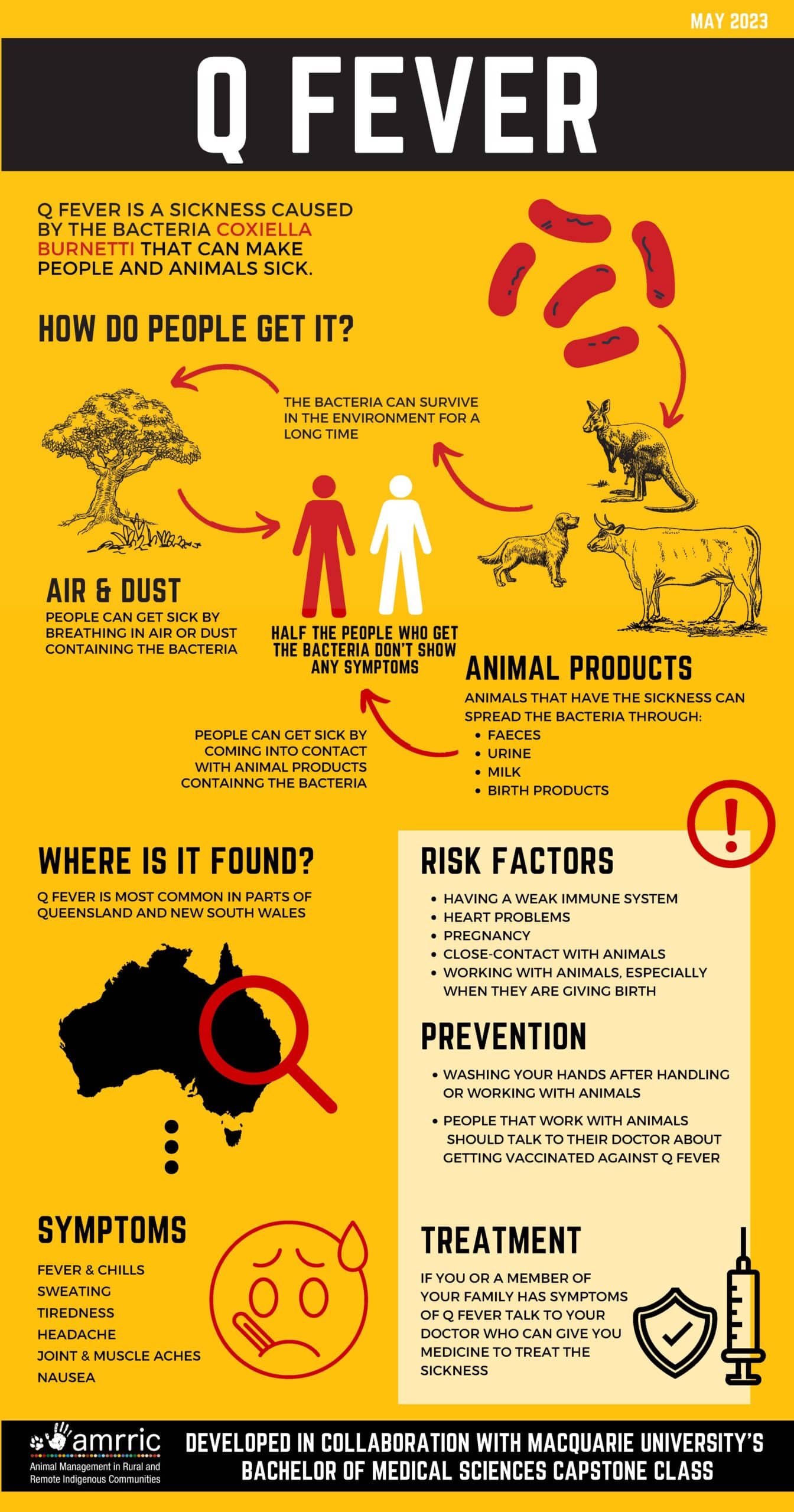Q Fever is a sickness caused by the bacteria Coxiella burnetii. Q Fever is a zoonotic disease, which can spread between people and animals. The bacteria is common in many animal species which can create a source of infection in the environment. People usually get the bacteria by breathing in dust that is contaminated with feces, urine or other fluids from animals that contain the bacteria. This means that people can get sick without ever coming into direct contact with an animal.

This fact sheet was developed by students in Macquarie University’s 2022 Medical Sciences Capstone/PACE subject major industry partnership project. The following references were provided by the students who developed the fact sheet:
Archer, B. N., Hallahan, C., Stanley, P., Seward, K., Lesjak, M., Hope, K., & Brown, A. 2017. Atypical outbreak of Q fever affecting low-risk residents of a remote rural town in New South Wales. Australian Government Department of Health and Aged Care. Available at: https://www1.health.gov.au/internet/main/publishing.nsf/Content/cda-cdi4102a.htm.
Anderson, A., Bijlmer, H., Fournier, P., Graves, S., Hartzell, J., Kersh, G. J., Limonard, G., Marrie, T. J., Massung, R. F., McQuiston, J. H., Nicholson, W. L., Paddock, C. D. & Sexton, D. J. 2013. Diagnosis and Management of Q Fever. Centers for Disease Control (CDC). https://www.cdc.gov/mmwr/preview/mmwrhtml/rr6203a1.htm?amp
Centers for Disease Control (CDC). 2019. Q fever: Epidemiology and Statistics. Centres for Disease Control and Prevention. https://www.cdc.gov/qfever/stats/index.html#:~:text=People%20at%20Risk,-%20More%20cases%20of&text=People%20who%20live%20or%20spend,chronic%20infection%20and%20severe%20disease.
Centers for Disease Control (CDC). 2019. Q fever: Transmission. Centres for Disease Control and Prevention. https://www.cdc.gov/qfever/transmission/index.html.
Fournier, P. E., Marrie, T. J. & Raoult, D. 1998. Diagnosis of Q fever. Journal of Clinical Microbiology, 36:1823-1834. https://doi.org:10.1128/JCM.36.7.1823-1834.
Garner, M. G., Longbottom, H. M., Cannon, R. M. & Plant, A. J. 1997. A review of Q fever in Australia 1991-1994. Australia and New Zealand Journal of Public Health, 21: 722-730. https://doi.org:10.1111/j.1467-842x.1997.tb01787.x.
Gidding, H. F., Peng, C. Q., Graves, S., Massey, P. D., Nguyen, C., Stenos, J., Quinn, H. E., McIntyre, P. B., Durrheim, D. N. & Wood, N. 2020. Q fever seroprevalence in Australia suggests one in twenty people have been exposed. Epidemiology & Infection, 148. https://doi.org:10.1017/S0950268.
Shaw, E. I. & Voth, D. E. 2019. Coxiella burnetii: A Pathogenic Intracellular Acidophile. Microbiology, 165: 1-3. https://doi.org:10.1099/mic.0.000707.
Hartzell, J.D., Wood-Morris, R.N., Martinez, L.J. & Trotta, R.F. 2008. Q fever: epidemiology, diagnosis, and treatment. Mayo Clinic Proceedings 83(5): 574-579. https://doi.org/10.4065/83.5.574.
Maurin, M. & Raoult, D. 1999. Q Fever. Clinical Microbiology Reviews 12: 518-553. https://doi.org:10.1128/cmr.12.4.518
Northern Territory Government. 2016. Q fever. Northern Territory Government: Bacterial infections. https://nt.gov.au/wellbeing/health-conditions-treatments/bacterial/qfever.
NSW Health. 2019. Q fever control guideline. NSW Health: Infectious Diseases. https://www.health.nsw.gov.au/Infectious/controlguideline/Pages/qfever.aspx#2.
NSW Health. 2021. Q fever. NSW Health: Vaccine preventable diseases. https://immunisationhandbook.health.gov.au/contents/vaccine-preventable-diseases/q-fever#contraindications-and-precautions.
Parker, N.R., Barralet, J.H. & Bell, A.M. 2006. Q fever. The Lancet, 367(9511): 679-688. https://doi.org/10.1016/S0140-6736(06)68266-4.
Seshadri, R., Paulsen, I. T., Eisen, J. A. & Heidelberg, J. F. 2003. Complete genome sequence of the Q-fever pathogen. Proceedings of the National Academy of Sciences 100: 5455-5460. https://doi.org:10.1073/pnas.0931379100.
Tozer, S., Wood, C., Si, D., Nissen, M., Sloots, T. & Lambert, S. 2020. The improving state of Q fever surveillance. Communicable Diseases Intelligence, 44. https://doi.org/10.33321/cdi.2020.44.48.